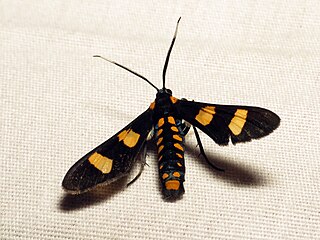Mallodeta is a monotypic moth genus in the family Erebidae described by Arthur Gardiner Butler in 1876. Its single species, Mallodeta clavata, was described by Francis Walker in 1854. It is found in Brazil and Paraguay.

Phoenicoprocta is a genus of tiger moths in the family Erebidae. The genus was erected by Herbert Druce in 1898.
Phoenicoprocta capistrata is a moth in the subfamily Arctiinae. The species was first described by Johan Christian Fabricius in 1775. It is found in the Caribbean and Brazil.
Leucotmemis insperata is a moth of the subfamily Arctiinae. It was described by Francis Walker in 1856. It is found in the Amazon region.
Phoenicoprocta partheni is a moth of the subfamily Arctiinae. It was described by Johan Christian Fabricius in 1793. It is found on Haiti.
Phoenicoprocta analis is a moth in the subfamily Arctiinae. It was described by Curt Schrottky in 1909. It is found in Paraguay.
Phoenicoprocta astrifera is a moth in the subfamily Arctiinae. It was described by Arthur Gardiner Butler in 1877. It is found in the Amazon region.
Phoenicoprocta haemorrhoidalis is a moth in the subfamily Arctiinae. It was described by Johan Christian Fabricius in 1775. It is found in Brazil.

Phoenicoprocta hampsonii is a moth in the subfamily Arctiinae. It was described by William Barnes in 1904. It is found in the United States in south-eastern Arizona and in Mexico's Baja California.
Phoenicoprocta lydia, the Lydia tiger moth, is a moth in the subfamily Arctiinae. It was described by Herbert Druce in 1889. It is found in Mexico and southern Texas.
Phoenicoprocta mexicana is a moth in the subfamily Arctiinae. It was described by Francis Walker in 1865. It is found in Mexico.
Phoenicoprocta rubiventer is a moth in the subfamily Arctiinae. It was described by George Hampson in 1898. It is found in Panama.
Phoenicoprocta sanguinea is a moth in the subfamily Arctiinae. It was described by Francis Walker in 1854. It is found in Honduras.
Phoenicoprocta teda is a moth in the subfamily Arctiinae. It was described by Francis Walker in 1854. It is found in Santa Catarina, Brazil.
Phoenicoprocta thera is a moth in the subfamily Arctiinae. It was described by Herbert Druce in 1889. It is found in Mexico.
Phoenicoprocta vacillans is a moth in the subfamily Arctiinae. It was described by Francis Walker in 1856. It is found in Colombia and the Brazilian states of São Paulo and Santa Catarina.
Phoenicoprocta jamaicensis is a moth in the subfamily Arctiinae. It was described by Schaus in 1901. It is found on Jamaica.

The Euchromiina are a subtribe of tiger moths in the family Erebidae. It was described by Arthur Gardiner Butler in 1876. Many species in the subtribe are mimics of wasps. Euchromiina have always been considered closely related to the subtribe Ctenuchina due to their similarity to moths and wasps. These two subtribes make up around 3,000 valid species, the majority of which occur in the Neotropics.



